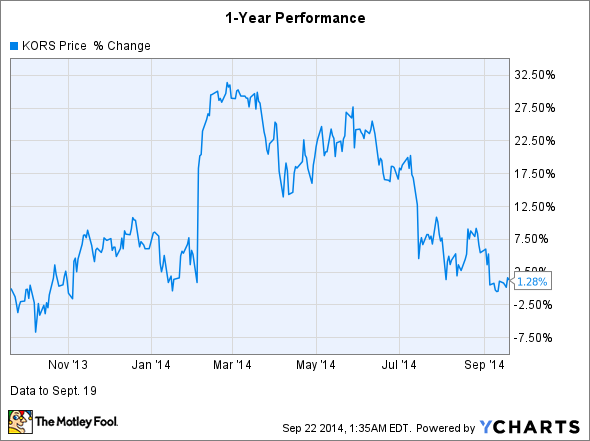
Source: Michael Kors.
Michael Kors (CPRI -1.67%) released its fiscal first-quarter 2015 results in July. The fast-growing accessible luxury lifestyle brand easily breezed by both revenue and earnings estimates, and it increased its fiscal 2015 revenue and earnings guidance. However, the market has punished the stock because of the company forecasting that comparable-store sales growth will slow in the current quarter and the full year, as well as concerns about margins.
Kors' stock price is down considerably from its one-year peak and all-time high, with returns now flat for the year. However, the longer-term picture remains very positive: The stock is up 218% since its December 2011 IPO.
So, is this a good time to buy Kors stock?
Valuation
Valuation has been shown to matter -- at least over the long term. Granted, absolute valuations for high-growth stocks such as Kors matter less than valuations for average and slower growers, in my opinion. However, it's usually wise for investors to pay some attention to absolute valuations and even more to relative valuations -- that is, relative to a company's closest peers and competitors.
So, let's look at how Kors stacks up to several other companies in the upscale fashion and accessories business. Coach (TPR -1.60%) is widely considered Kors' closest competitor, as their product lines are quite similar, though not exactly. They each generate the bulk of their revenue from sales of handbags and small leather goods. This category makes up about 70% of Kors' business. While Ralph Lauren's offerings slant heavily toward the apparel side, it shares Kors' upscale focus, so it's included to provide more context.
|
Company |
Market Cap |
Price/Sales |
P/E |
P/E (FRW) |
5-Year PEG |
|---|---|---|---|---|---|
|
Kors |
15.7B |
4.4 |
23.9 |
16.1 |
0.8 |
|
Coach |
10.2B |
2.1 |
11.3 |
17.7 |
3.4 |
|
Ralph Lauren |
15.1B |
2.0 |
20.4 |
17.3 |
2.1 |
Source: Yahoo! Finance; data as of Sept. 19.
Before we dig into these numbers, here's the bigger-picture context: The average P/S and forward P/E for stocks in the S&P 500 are 1.7 and 15.7, respectively. However, it's important to note that Kors is growing earnings considerably faster than the average stock in the index, which only increased earnings about 5% in 2013.
Valuations for these three companies vary widely. The price-to-sales ratio can add some insight, though it's a more important metric for companies that don't have price-to-earnings ratios. It's a weaker metric than the P/E for companies with earnings, as stock prices move based on earnings growth. So, let's focus on the P/E ratios and the 5-year PEG. (The PEG is the P/E divided by future growth estimates; in this case, for the five-year period.)
Kors is the most richly valued based on trailing-12-month earnings, though it has the lowest valuation based on analysts' projected 1-year forward earnings and on a 5-year PEG basis.
The PEG is a better metric, in my opinion, than the P/E ratio because it takes growth into account. That said, 5-year PEGs are based on analysts' estimates for five years out, so I wouldn't put too much stock (no pun intended) in them. That's especially true in the fickle fashion world, where what's hot can become cold rather quickly.
Investors shouldn't look at valuation measures such as the P/E and P/S in a vacuum, but along with current and future projected growth.
| Company | 1-Year EPS Growth | FY 2015 Est. EPS Growth | FY 2016 Est. EPS Growth |
| Kors | 61.5% | 26.1% | 17.7% |
| Coach | (23.2)% | (39.0)% | 10.6% |
| Ralph Lauren | 2.6% | 3% | 14.6% |
Kors' and RL's fiscal years end in March, and Coach's in June. Sources: Yahoo! Finance and YCharts; data as of Sept. 19.
The first column shows actual results, while the others are analysts' estimates. Kors' EPS growth has been torrid over the last year. However, after last quarter's results were released, fears reignited that the company's growth -- on both a same-store and overall basis -- was slowing, sending the stock tumbling. Granted, investing in a stock while it's in an accelerating growth mode often brings the highest returns. That said, fast-growing companies all eventually show slowing growth, as the larger a company becomes, the more difficult it gets to post the same growth on a percentage basis. However, this doesn't mean the stock's best days are behind it. Kors is projected to grow 29.1% this fiscal year and 17.7% next fiscal year. That's great growth. Further, the company has typically beat earnings estimates, so these numbers could prove conservative. Two possible catalysts for outperformance are the company's continued international expansion and its planned deeper penetration of the menswear market.
Of course, there are downside possibilities, too. The biggest by far is that the tide could turn, and the company could lose its "it" status with consumers. This eventually happens to all, or nearly all, red-hot fashion names, as newness is part of the appeal to many.
The Foolish takeaway
On an absolute basis, Michael Kors is still a pricey stock. However, on a relative basis -- compared to its peers -- and given its projected future growth, it's reasonably priced. In fact, its 5-year PEG of less than 1.0 suggests that it's a good buy. The caveat: There's no guarantee analysts' estimates will pan out.
It seems more likely than not that Kors still has plenty of room to run. However, given fashion's fickleness factor, it's a stock best suited for investors who regularly monitor their holdings.





